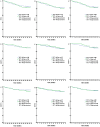Effect of Prolonged Radiotherapy Treatment Time on Survival Outcomes after Intensity-Modulated Radiation Therapy in Nasopharyngeal Carcinoma
- PMID: 26506559
- PMCID: PMC4624640
- DOI: 10.1371/journal.pone.0141332
Effect of Prolonged Radiotherapy Treatment Time on Survival Outcomes after Intensity-Modulated Radiation Therapy in Nasopharyngeal Carcinoma
Abstract
Purpose: To estimate the influence of prolonged radiation treatment time (RTT) on survival outcomes in nasopharyngeal carcinoma after continuous intensity-modulated radiation therapy.
Methods and materials: Retrospectively review 321 patients with NPC treated between October 2009 and December 2010 and all of them underwent simultaneous accelerated intensity-modulated radiation therapy. The fractionated dose was 2-2.47 Gy/F (median 2.27 Gy), and the total dose for nasopharyngeal region was 64-74 Gy/ 28-33 fractions. The association of prolonged RTT and treatment interruption with PFS, LRFS and DFFS were assessed by univariate analysis and multivariate analysis. Survival analyses were carried out using Kaplan-Meier methodology and the log-rank test was used to assess the difference. The Cox regression proportional hazard model was used for multivariate analyses and evaluating the prognostic parameters for PFS, LRFS and DFFS.
Results: Univariate analysis revealed no significant associations between prolonged RTT and PFS, LRFS, DFFS when dichotomized using various cut-off values (all P>0.05). In multivariate analysis, RTT (range, 36-63 days) as a continuous variable, had no influence on any survival outcome as well (P>0.05). T and N classification were independent prognostic factors for PFS, LRFS and DFFS (all P<0.05, except T classification for LRFS, P = 0.057). Age was an independent prognostic factor for PFS (hazard ratio [HR], 1.033; P = 0.008) and DFFS (HR, 1.032; P = 0.043).
Conclusion: We conclude that no such association between survival outcomes and radiation treatment duration (range: 36-63 days) can be found in the present retrospective study, however, we have to remind that prolongation in treatment should be limited in clinical application and interruptions caused by any reason should be minimized as much as possible.
Conflict of interest statement
Figures


References
-
- Vokes EE, Liebowitz DN, Weichselbaum RR. Nasopharyngeal carcinoma. Lancet. 1997;350(9084):1087–91. - PubMed
-
- Lee N, Xia P, Quivey JM, Sultanem K, Poon I, Akazawa C, et al. Intensity-modulated radiotherapy in the treatment of nasopharyngeal carcinoma: an update of the UCSF experience. International journal of radiation oncology, biology, physics. 2002;53(1):12–22. - PubMed
-
- Huncharek M, Kupelnick B. In regards to Baujat et al.: Chemotherapy in locally advanced nasopharyngeal carcinoma: An individual patient data meta-analysis of eight randomized trials and 1753 patients (Int J Radiat Oncol Biol Phys 2006;64:47–56). International journal of radiation oncology, biology, physics. 2006;65(3):958; author reply -9. - PubMed
Publication types
MeSH terms
LinkOut - more resources
Full Text Sources
Other Literature Sources

